
WHY, does the world remain in pain? Because we have muzzled God. We have rejected His prophets and ignored His mother. In our pride, we have succumbed to Rationalism, and the Death of Mystery. And thus, today’s first reading cries out to a tone-deaf generation:
O that you had hearkened to my commandments! Then your peace would have been like a river, and your righteousness like the waves of the sea. (Isaiah 48:18; RSV)
As the Church descends into a crisis of confusion and the world stands on a precipice of chaos, it’s as if Heaven is crying out to us through today’s Gospel:
‘We played the flute for you, but you did not dance, we sang a dirge but you did not mourn’… John came neither eating nor drinking, and they said, ‘He is possessed by a demon.’ The Son of Man came eating and drinking and they said, ‘Look, he is a glutton and a drunkard, a friend of tax collectors and sinners.’
And the Blessed Mother came as a Queen of Peace, but they said, ‘She is too chatty, banal, and frequent.’ But, Jesus replies:
Wisdom is vindicated by her works. (Today’s Gospel)
A tree is known by its fruits. And so, here is what happened when humble souls, alive to the will of God, did not “despise prophetic utterances”, but “tested everything” and “retained what was good” (1 Thessalonians 5:20-21).
THE LITTLE ONES
The fact is that souls such as Noah, Daniel, Moses and David constantly discerned God’s will through the “private revelations” given to them. It was 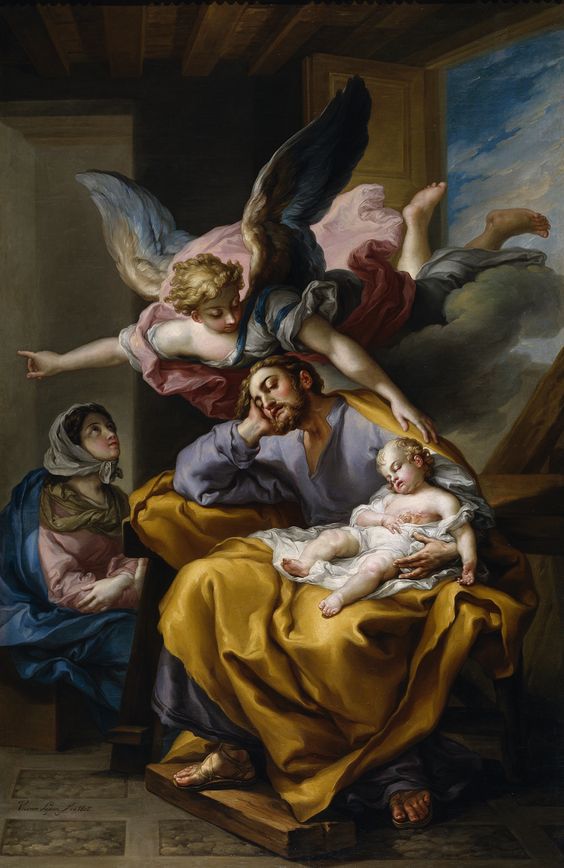 a “private revelation” that inaugurated the Incarnation. It was a “private revelation” that inspired St. Joseph to flee with Mary and the Christ child to Egypt. St. Paul was converted through a “private revelation” when Christ knocked him off his high horse. Portions of Paul’s letters were also “private revelations” transmitted to him through visions and mystical experiences. Indeed, the entire Book of Revelation given to St. John was a “private revelation” through visions.
a “private revelation” that inaugurated the Incarnation. It was a “private revelation” that inspired St. Joseph to flee with Mary and the Christ child to Egypt. St. Paul was converted through a “private revelation” when Christ knocked him off his high horse. Portions of Paul’s letters were also “private revelations” transmitted to him through visions and mystical experiences. Indeed, the entire Book of Revelation given to St. John was a “private revelation” through visions.
All of these men and Our Lady lived in a time when people were not only open to listening to God’s voice, but expected it. Now, because they preceded Christ or because of their proximity to Him, the Church considers these “private revelations” to constitute part of the “deposit of faith.”
The following souls also received “private revelation” that, while not considered part of that definitive “Public Revelation” of Christ, yet demonstrate how important, if not crucial, that listening to prophecy is in the life of the Church.
I. Desert Fathers (3rd Century A.D.)
In order to escape temptation and the “noise” of the world, many men and women took the following Scripture more literally:
“…come forth from them and be separate,” says the Lord, and touch nothing unclean; then I will receive you and I will be a father to you, and you shall be sons and daughters to me… (2 Cor 6:17-18)
In the early centuries of the Church, they fled into the desert, and there, through the mortification of their flesh and interior silence and prayer, God revealed the spirituality that would form the basis for the monastic life of the Church. Many a pope has attributed to the holy souls, who have consecrated themselves to monastic life in the abbeys and cloisters of the Church, as being the ones whose prayers have sustained the People of God in her most difficult hours.
II. St. Francis of Assisi (1181-1226)
A man once consumed by riches and glory, young Francesco one day passed by the chapel of San Damiano in Italy. Gazing at a small crucifix, the future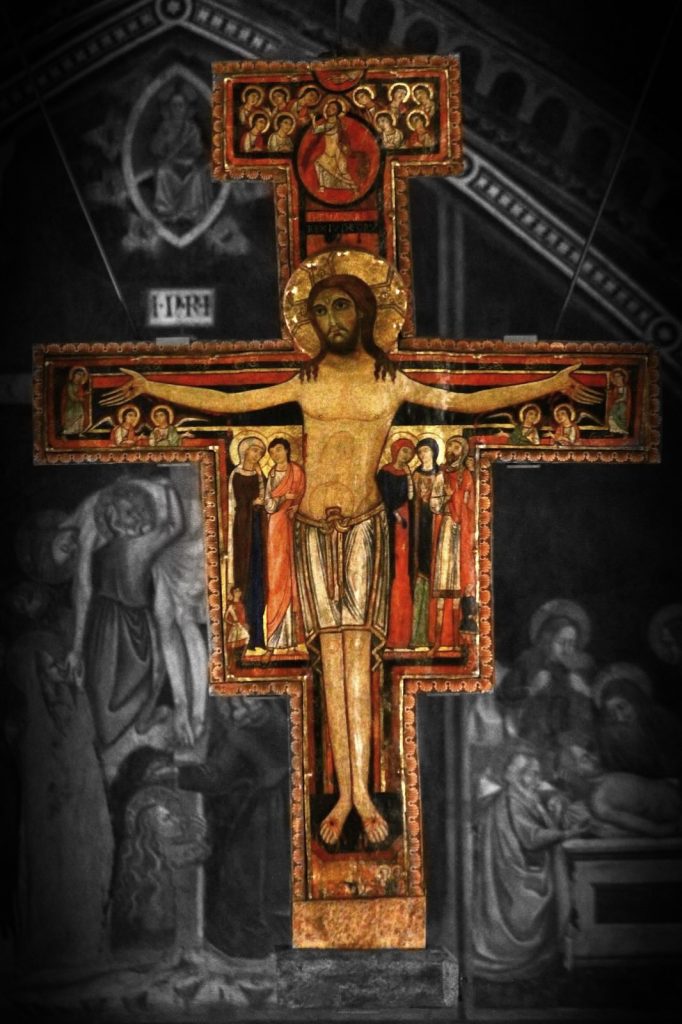 St. Francis of Assisi heard Jesus say to him: “Francis, Francis, go and repair My house which, as you can see, is falling into ruins.” It was only later that Francis realized that Jesus was referring to His Church.
St. Francis of Assisi heard Jesus say to him: “Francis, Francis, go and repair My house which, as you can see, is falling into ruins.” It was only later that Francis realized that Jesus was referring to His Church.
To this day, the obedience of St. Francis to that “private revelation” has influenced the lives of countless millions, including the present Pope, and has spawned thousands of apostolates worldwide that have put spiritual and physical poverty at the service of the Gospel.
III. St. Dominic (1170-1221)
At the same time that St. Francis was being raised to counter the worldliness spreading in the Church, St. Dominic was being equipped to battle a spreading heresy—Albigensianism. It was the belief that everything material, including the human body, was essentially created by an evil entity while God created the spirit, which is good. It was a direct attack against not only the Incarnation, Passion and Resurrection of Jesus, but therefore also Christian morality and the saving message of the Gospel.
The “rosary” at that time was called the “poor man’s Breviary.” The monastics meditated on the 150 Psalms as part of the ancient practice of the Office. However, those who couldn’t, simply prayed the “Our Father” on 150 wooden beads. Later, the first part of the Ave Maria (“Hail Mary”) was added. But then, in 1208 while St. Dominic was praying alone in a forest, begging Heaven to help him overcome this heresy, a ball of fire and three holy angels appeared in the sky, after which the Virgin Mary spoke to him. She said that the Ave Maria would give his preaching power and taught him to 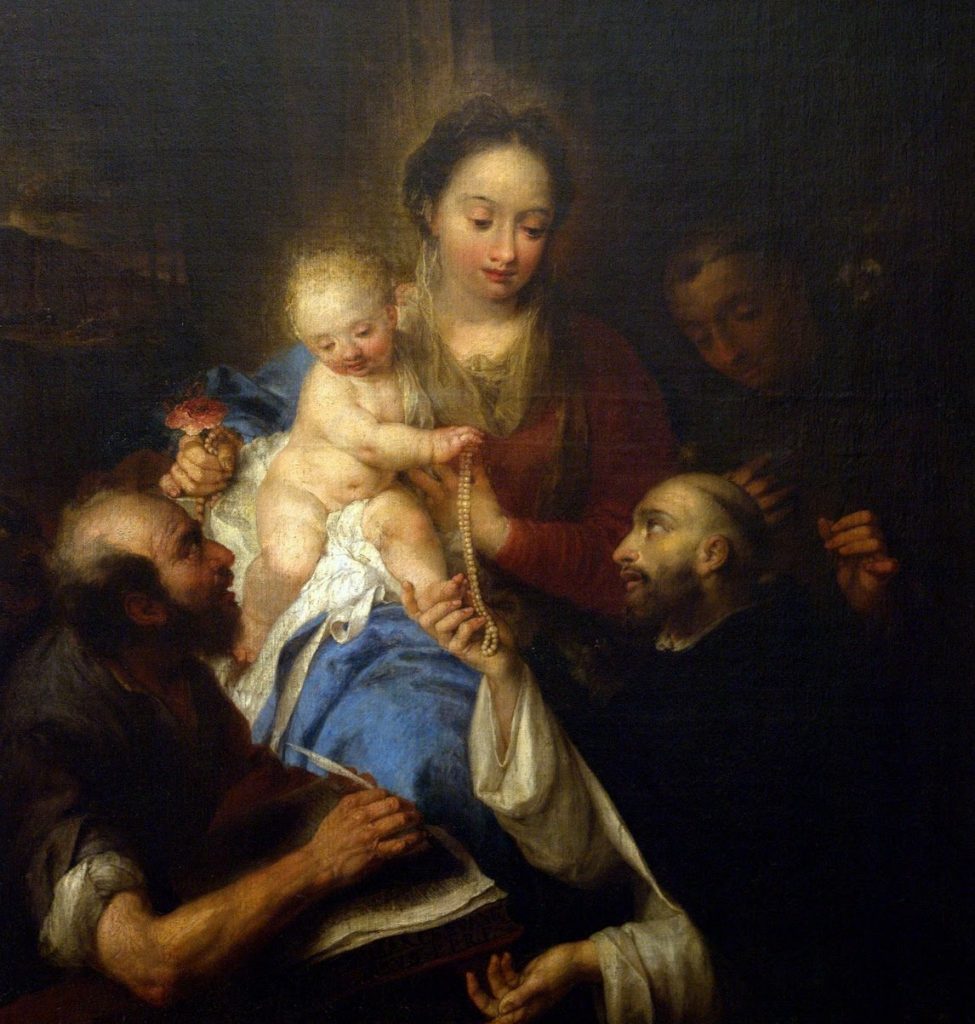 incorporate the mysteries of Christ’s life into the Rosary. This “weapon” Dominic, in turn, took to the villages and towns where the cancer of Albigensianism had spread.
incorporate the mysteries of Christ’s life into the Rosary. This “weapon” Dominic, in turn, took to the villages and towns where the cancer of Albigensianism had spread.
Thanks to this new method of prayer… piety, faith, and union began to return, and the projects and devices of the heretics to fall to pieces. Many wanderers also returned to the way of salvation, and the wrath of the impious was restrained by the arms of those Catholics who had determined to repel their violence. —POPE LEO XIII, Supremi Apostolatus Officio, n. 3; vatican.va
Indeed, the victory of the Battle of Muret was attributed to the Rosary, in which 1500 men, under the Pope’s blessing, defeated an Albigensian stronghold of 30,000 men. And then again, the victory of the Battle of Lepanto in 1571 was attributed to Our Lady of the Rosary. In that battle, the much larger and better trained Muslim navy, with the wind at their backs and a dense fog obscuring their assault, bore down on the Catholic navy. But back in Rome, Pope Pius V led the Church in praying the Rosary at that very hour. The winds suddenly shifted behind the Catholic navy, as did the fog, and the Muslims were defeated. In Venice, the Venetian senate commissioned the construction of a chapel dedicated to Our Lady of the Rosary. The walls were lined with records of the battle and an inscription which read:
NEITHER VALOR, NOR ARMS, NOR ARMIES, BUT OUR LADY OF THE ROSARY GAVE US VICTORY! —Champions of the Rosary, Fr. Don Calloway, MIC; p. 89
Since then, the popes have “proposed the Rosary as an effective spiritual weapon against the evils afflicting society.” [1]POPE ST. JOHN PAUL II, Rosarium Virginis Mariae, n. 2; vatican.va
The Church has always attributed particular efficacy to this prayer, entrusting to the Rosary, to its choral recitation and to its constant practice, the most difficult problems. At times when Christianity itself seemed under threat, its deliverance was attributed to the power of this prayer, and Our Lady of the Rosary was acclaimed as the one whose intercession brought salvation. Today I willingly entrust to the power of this prayer… the cause of peace in the world and the cause of the family. —POPE ST. JOHN PAUL II, Rosarium Virginis Mariae, n. 39; vatican.va
Indeed, it would seem that future victories in the Church would overwhelmingly be through that “Woman clothed in the sun” who would crush the head of the serpent time and again.
IV. St. Juan Diego (1520-1605)
In 1531, Our Lady appeared to a humble peasant in what is now known as Mexico. When St. Juan saw her, he said: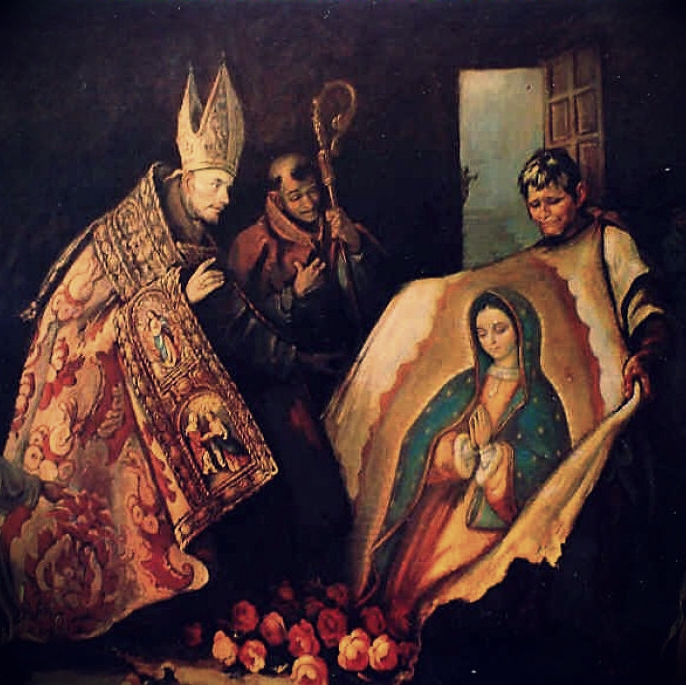
…her clothing was shining like the sun, as if it were sending out waves of light, and the stone, the crag on which she stood, seemed to be giving out rays. —Nican Mopohua, Don Antonio Valeriano (c. 1520-1605 A.D,), n. 17-18
As proof that she was appearing, she helped St. Juan fill his tilma with flowers—particularly Castilian roses native to Spain—to give to the Spanish bishop. When Juan opened his tilma, the flowers fell to the ground and the image of Our Lady appeared on the cloak right in front of the bishop’s eyes. That image, still hanging today in the Basilica in Mexico City, was the instrument God used to bring human sacrifice to an end and convert up to nine million Aztecs to Christianity.
But it first began with the instrument of “private revelation” to St. Juan, and his humble “yes” to Our Lady. [2]cf. Living the Book of Revelation As a sidenote… Admiral Giovanni Andrea Doria carried a copy of the image of Our Lady of Guadalupe on his ship when they fought at Lepanto.
V. St. Bernadette Soubirous (1844-1879)
Bernadette… heard a noise like a gust of wind, she looked up towards the Grotto : “I saw a lady dressed in white, she wore a white dress, an equally white veil, a blue belt and a yellow rose on each foot.” Bernadette made the Sign of the Cross and said the Rosary with the lady. —www.lourdes-france.org
In one of the apparitions to the fourteen year old girl, Our Lady, who called herself “The Immaculate Conception,” asked Bernadette to dig away the dirt on the ground at her feet. When she did, water began to spring up, which Our Lady asked her to drink. The next day, the muddy water was clear and continued to flow…. as it does to this very day. Since then, thousands of people have been miraculously healed in the waters of Lourdes.
VI. St. Margaret Mary Alacoque (1647-1690) and Pope Clement XIII
As a precursor to the message of Divine Mercy, Jesus appeared to St. Margaret in a chapel Paray-le-Monial, France. There, He revealed His Sacred 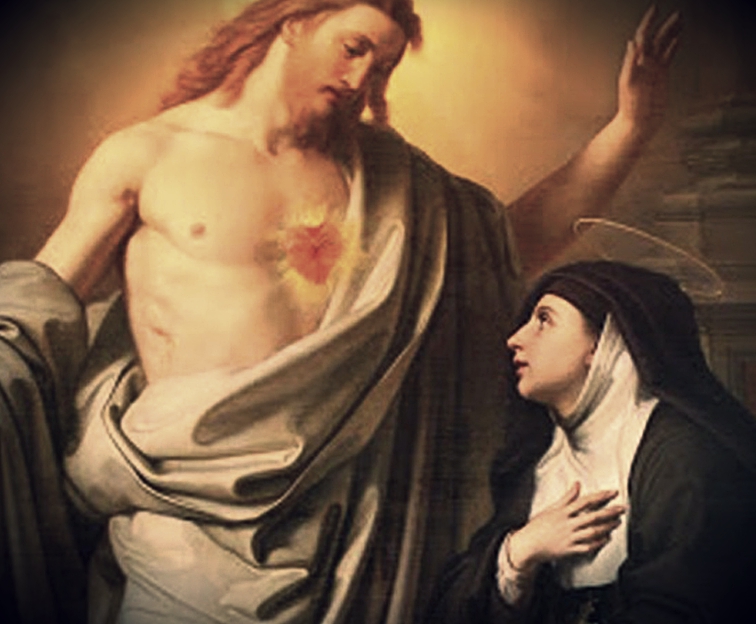 Heart on fire for love of the world, and asked her to spread devotion to It.
Heart on fire for love of the world, and asked her to spread devotion to It.
This devotion was the last effort of His love that He would grant to men in these latter ages, in order to withdraw them from the empire of Satan which He desired to destroy, and thus to introduce them into the sweet liberty of the rule of His love, which He wished to restore in the hearts of all those who should embrace this devotion. —St. Margaret Mary, www.sacredheartdevotion.com
The devotion was approved by Pope Clement XIII in 1765. To this day, the image of Jesus pointing to His Heart remains hanging in many homes, reminding them of the love of Christ and the Twelve Promises He made to those who honor His Sacred Heart. Among them, the establishment of peace in homes and that “Sinners will find in My Heart an infinite ocean of mercy.”
VII. St. Faustina (1905-1938) and St. John Paul II
The “language” of His Heart, that “ocean of mercy,” would be expressed more fully to St. Faustina Kowalska, His “secretary of Divine Mercy.” She recorded in her diary some of the most moving and beautiful words of Jesus to a broken and war-torn world. The Lord also asked that His image be painted with the words “Jesus, I trust in You” added to the bottom. Among His promises attached to the image: “The soul that will venerate this image will not perish.” [3]cf. Divine Mercy in My Soul, Diary, n. 48 Jesus also asked that the Sunday after Easter be proclaimed “the feast of Divine Mercy”, and He said that the image, the Feast, and His message of Mercy were “a sign for the end times.” [4]Divine Mercy in My Soul, Diary, n. 848
I am giving them the last hope of salvation; that is, the Feast of My Mercy. If they will not adore My mercy, they will perish for all eternity… tell souls about this great mercy of Mine, because the awful day, the day of My justice, is near. —Divine Mercy in My Soul, Diary of St. Faustina, n. 965
Heeding this “private revelation”, in the year 2000 at the dawn of the third millennium — “the threshold of hope” — St. John Paul II instituted the Divine Mercy Feast, as Christ requested.
VIII. St. John Paul II (1920-2005)
In the apparitions at Fatima in 1917, Our Lady requested the consecration of Russia to her Immaculate Heart in order to prevent the spread of the “errors” of Russia and the consequences therewith. However, her requests were not heeded or done according to her desire.
After the assassination attempt upon his life, St. John Paul II immediately thought of consecrating the world to the Immaculate Heart of Mary. He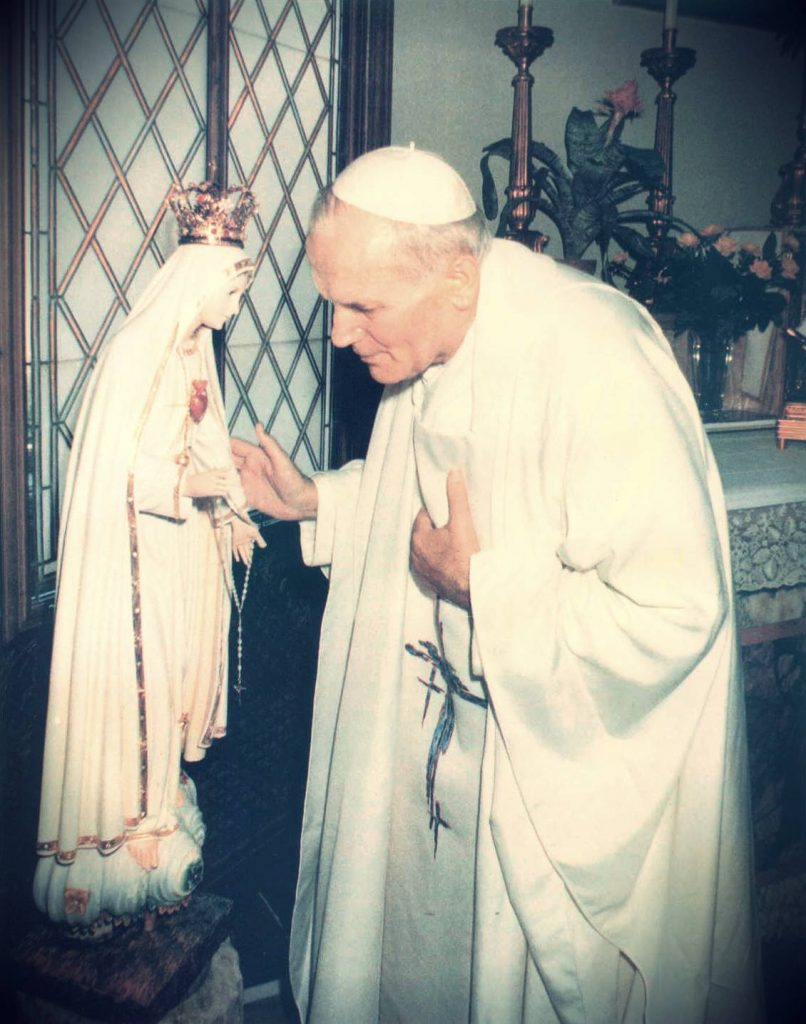 composed a prayer for what he called an “Act of Entrustment.” He celebrated this consecration of the “world” in 1982, but many bishops did not receive invitations in time to participate (and thus, Sr. Lucia said the consecration did not fulfill the necessary conditions). Then, in 1984, John Paul II repeated the consecration with the intent of naming Russia. However, according to the organizer of the event, Fr. Gabriel Amorth, the Pope was pressured not to name the Communist country, then part of the U.S.S.R. [5]see Russia… Our Refuge?
composed a prayer for what he called an “Act of Entrustment.” He celebrated this consecration of the “world” in 1982, but many bishops did not receive invitations in time to participate (and thus, Sr. Lucia said the consecration did not fulfill the necessary conditions). Then, in 1984, John Paul II repeated the consecration with the intent of naming Russia. However, according to the organizer of the event, Fr. Gabriel Amorth, the Pope was pressured not to name the Communist country, then part of the U.S.S.R. [5]see Russia… Our Refuge?
Setting aside the often heated debate on whether or not Our Lady’s requests were properly fulfilled, one could argue, at the very least, that there was an “imperfect consecration.” For shortly after, the “Iron Wall” fell and Communism collapsed. Since then, churches are being built in Russia at a stunning pace, Christianity is publicly endorsed by the government, and the immorality so widely promoted by Western governments has been stonewalled by the Russian State. The turnaround, in a word, has been stunning.
IX. The priests of Hiroshima
Eight Jesuit priests survived the atomic bomb that was dropped on their city… only 8 blocks from their home. Half a million people were annihilated around them, but the priests all survived. Even the nearby church was completely destroyed, but the house they were in was minimally damaged.
We believe that we survived because we were living the message of Fatima. We lived and prayed the Rosary daily in that home. —Fr. Hubert Schiffer, one of the survivors who lived another 33 years in good health with not even any side-effects from radiation; www.holysouls.com
X. The Chapel of Robinsonville, WI (now Champion)
As fires burn through California today, I am reminded of the storm system that resulted in the Great Chicago Fire of 1871 and Peshtigo Fire that destroyed 2,400 square miles and killed 1,500 to 2,500 people.
Our Lady had appeared in 1859 to Adele Brise, a Belgian-born woman, which later became the first “approved” apparition in the United States. But 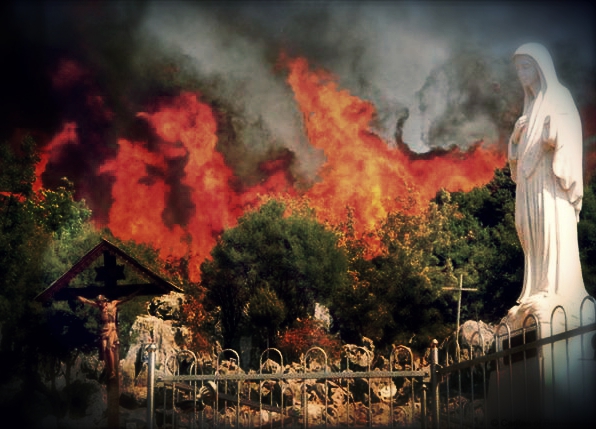 in 1871, as the fire approached their chapel, Brise and her companions knew they could not escape. So they took up the statue of Mary and bore it in procession around the grounds. The fire “miraculously” went around them:
in 1871, as the fire approached their chapel, Brise and her companions knew they could not escape. So they took up the statue of Mary and bore it in procession around the grounds. The fire “miraculously” went around them:
…the houses and fences in the neighborhood had been burned with the exception of the school, the chapel and fence surrounding the six acres of land consecrated to the Blessed Virgin. —Fr. Peter Pernin, Canadian missionary serving in the area; thecompassnews.org
The fire occurred on the eve of the anniversary of the apparition. Very early the next day, the rains appeared and extinguished the flames. To this day, on the eve of the anniversary until the next morning, an all night candle and prayer vigil is held at the site, which is now The National Shrine of Our Lady of Good Help. Another sidenote: Adele and her companions were Third Order Franciscans.
–––––––––––––––
There are so many other stories that could be told of humble souls who, listening to and heeding the “private revelation” given to them, have impacted not only those around them, but evidently the future of humanity.
Blessed the man who follows not the counsel of the wicked… but delights in the law of the LORD… He is like a tree planted near running water, that yields its fruit in due season, and whose leaves never fade. (Today’s Psalm)
The question that begs serious reflection is, what if any one of the individuals above rejected the revelation that they were given because it was “private revelation” and “therefore, I don’t have to believe it”? We would do well to reflect on what this means for us as Our Lady continues to appear and implore our cooperation, in numerous places throughout the world, at this hour.
Do not despise prophetic utterances. Test everything; retain what is good. Refrain from every kind of evil. (1 Thess 5:20-22)
Indeed, upon my servants and my handmaids I will pour out a portion of my spirit in those days, and they shall prophesy… So, my brothers, strive eagerly to prophesy… (Acts 2:18; 1 Cor 14:39)
You are loved.
To journey with Mark in the The Now Word,
click on the banner below to subscribe.
Your email will not be shared with anyone.
Footnotes
| ↑1 | POPE ST. JOHN PAUL II, Rosarium Virginis Mariae, n. 2; vatican.va |
|---|---|
| ↑2 | cf. Living the Book of Revelation |
| ↑3 | cf. Divine Mercy in My Soul, Diary, n. 48 |
| ↑4 | Divine Mercy in My Soul, Diary, n. 848 |
| ↑5 | see Russia… Our Refuge? |


